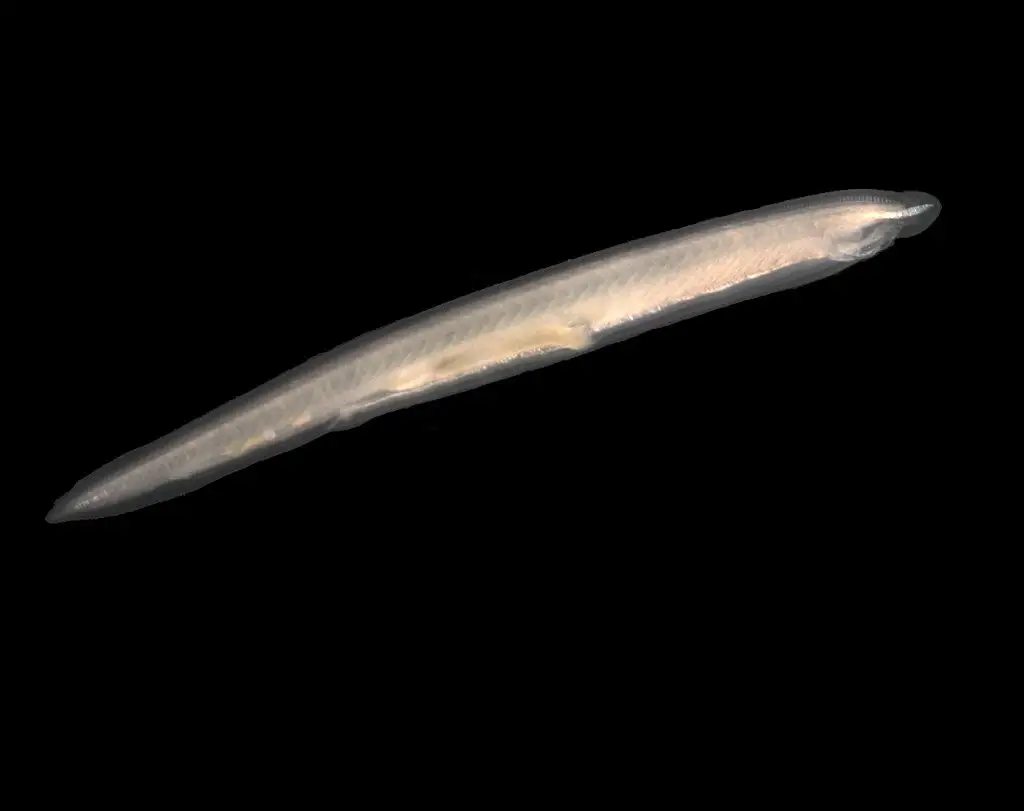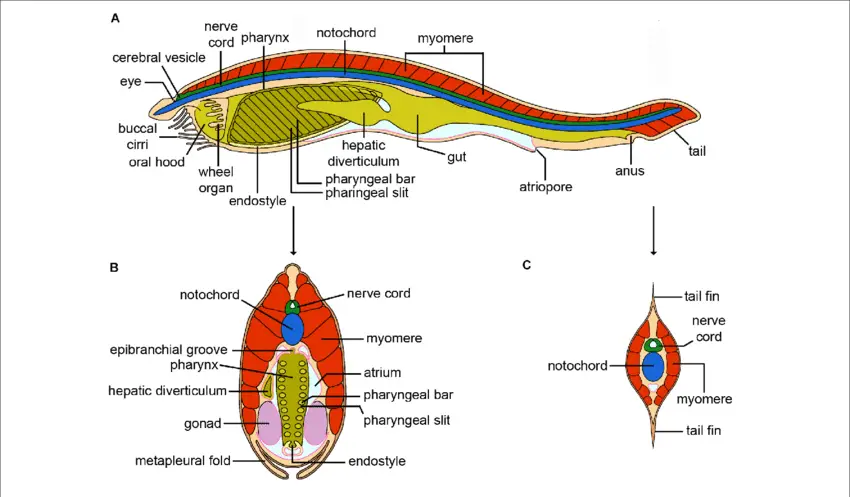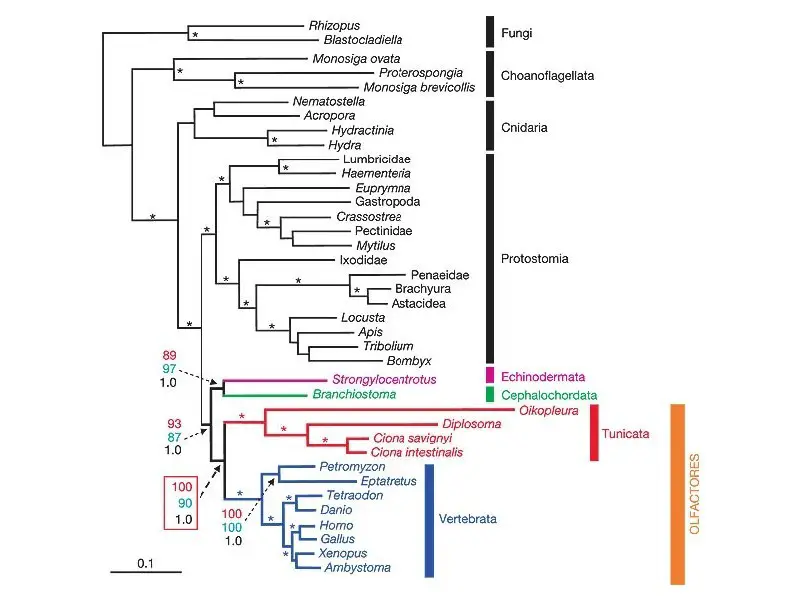Table of Contents
Characteristics Features of Subphylum Cephalochordata:
- They are marine and found in all around the world but present in abundance in warmer sea in shallow coastal areas.
- Most of the time in the day they present inside the tubular sand burrows with keeping the anterior part outside of the burrows and remaining part inside the burrow.
- Body is transparent to translucent due to presence of transparent body wall, they are around 6 cm long fish like marine animals.
- Body is divided into two parts, anterior trunk and posterior slender tail, head absent.
- Body is covered with single layer epidermal cells, no exoskeleton present, no paired appendages present.
- The muscle fibres show special arrangements in two sides of the body and each segment of muscle are known as myotomes.
- During embryonic development coelom developed from the archenteron, so in Cephalochordata the coelom is enterocoelous type. The coelom is reduced in pharynx region due to large sized pharynx and the atrial cavity.
- The pharynx is surrounded by atrial cavity, the pharynx have large number of gill slits and the gill slits do not open directly into outside, open into the atrial cavity.
- The dorsal notochord present throughout the length of their body and it extend upto the rostrum beyond the brain.
- Respiration occur through the general surface of metapleural folds, fins but the pharyngeal gill slits do not take part in respiration significantly.
- Closed circulatory system without heart, the contractile muscular wall of blood vessels give directions to the blood inside the blood vessels. Hepatic portal system present, no respiratory pigment present in the blood.
- Excretion occur through protonephridia with tuft of solenocytes.
- The hollow dorsal nervecord is filled with cerebrospinal fluid, a brain like enlargement present on anterior side of the nervecord but it is not actually brain. The nervecord have nerve with separate dorsal and ventral root.
- Male and female are separate but sexual dimorphism absent, the gonads present on lateral side in longitudinal rows each gonads in each body segments, the gonads do not have gonoducts.
- Gametes release in sea water and fertilization occur inside the water externally, development include free swimming larval stage.
Detailed Study on Characteristics of Subphylum Cephaochordata

Primitive Characters in Cephalochordata:
- The body of Cephalochordata show assymetry which is an primitive character and it generally observed in Non-chordate.
- In Cephlaochordata well developed brain absent, an enlargement on nervecord present but it is not actually brain.
- The median fins are unpaired there are no paired appendages or limbs present in Cephalochordata.
- Their body wall covered with single layer epidermal tissue and the dermis layer absent.
- The coelom is enterocoelous type, due embryonic development larval archenteron form the coelom.
- The peculiar segmentation in the lateral muscle or myotomes are a primitive features in them.
- In Cephalochordata there are no exoskeleton or endoskeleton, the notochord present entire length of the body but it not develop vertebral column.
- Large sized pharynx with endostyle, large number of pharyngeal gill slits and cilliary mode of feeding is primitive character of Cephalochordata.
- The digestive system do not have liver but the midgut diverticulum represent the liver.
- There are no heart in blood Vascular System of Cephalochordata, no respiratory pigment present in blood.
- No special respiratory system, excretion occur through protonephridia.
- Nervecord do not develop brain, sensory organs are simple and not paired.
- Gonads present in large numbers, gonads do not have gonoducts only open outside through gonopore.
- Small sized eggs with very small amount of yolk and the gonads do not show sexual dimorphism.
Degenerate Character in Cephalochordata:
- The ventricle present in enlarged portion of nervecord in Cephalochordata represent that there must be a phase in the lifecycle of Cephalochordata when they have proper brain with ventricle. But with time the earlier Cephalochordata undergoes degeneration and become brainless.
- The fins are supported by connective tissue box but there are no cartilaginous or bony endoskeletal structure, it may be due to degeneration.
- The gonads do not have any gonoducts, open through gonopore, it is also a degenerate features in Cephalochordata.
Specialized or Peculiar Features in Cephalochordata:
- The notochord is abnormal developed in Cephalochordata, the notochord extend upto the rostrum beyond the brain portion, the notochord present inside the rostrum help in making burrows.
- The buccal cirri present along the oral hood help in filtering the food particles and mouth is not bordered with jaws.
- The velar membrane present in digestive tract and velar tentacles is a peculiar features in Cephalochordata.
- Major collection of food occur in pharynx, the large pharyngeal cavity enables them to collect food efficiently.
- Wheel organ present in oral hood region, the Hatschek’s groove and Hatschek’s pit present in buccal cavity is peculiar.
- The coelom is reduced due to atrial cavity, the pharyngeal gill slits open into atrial cavity and the atrial cavity open outside through atripore.
Detailed Study on Primitive Degenerate and Specialised Features of Subphylum Cephalochordata
Classification of Subphylum Cephalochordata:
Subphylum Cephalochordata has only a class, class Leptocardii, class Leptocardii have only one family Branchiostomidae. Family Branchiostomidae has two genera, Branchiostoma and Assymetron. Genus Branchiostoma has 8 species, in genus Asymmetron there are 7 species, in Asymmetron the gonads present only one side on the right side, metapleural folds are asymmetric in genus Asymmetron.

Affinities of Cephalochordata with Non-Chordata:
- Annelida: Cephalochordata show metameric segmentation, metamerism present in Cephalochordata, the protonephridia present in Cephalochordata as excretory organ also present in some polychaetes. The filter feeding mechanism observed in Cephalochordata is also present in some Polychaetes, closed blood vascular system. But in Annelida the metamerism present extensively, in Cephalochordata the segmentation observed in only muscle and in gonads. Generally the coelom in Annelida is schizocoelic type but in Cephalochordata the coelom is reduced and enterocoelous type.
- Mollusca: Mollusca perform filter feeding mechanism as observed in Cephalochordata, respiratory mechanism is also similar in Cephlaochordata and Mollusca. But the segmentation observed in Cephalochordata is absent in Mollusca, the podium present in Mollusca is not present in Cephalochordata.
- Echinodermata: Assymetry in Cephalochordata and Echinodermata are similar, the coelom in Cephalochordata and Echinodermata is enterocoelous type. The perforation in the calyx of fossil Echinodermata show similarity with the pharynx gill slits in Cephalochordata.
Detailed Study on Affinities of Cephalochordata with Non-Chordata
Affinities of Cephalochordata with Chordata:
- Hemichordata: Numerous gill slits and gill bars present in Hemichordata and Cephalochordata show much similarity. Food collection through filter feeding mechanism and the respiratory mechanism is also similar in Cephalochordata and Hemichordata. Large number of gonads without gonoducts and enterocoelous type of coelom is observed in both Cephalochordata and Hemichordata.
- Urochordata: Large sized pharyngeal cavity with large number of gill slits and gill bars, ciliary feeding mechanism, respiratory mechanism is similar in Cephalochordata and Urochordata. Atrial cavity with opening outside through siphon in Urochordata and atriopore in Cephalochordata show much similarity.
- Cyclostomata: The elongated fish like slender body of Cyclostomata also observed in Cephalochordata. Pharynx with endostyle, dorsal median fin, mouth with oral hood, velum all are similar in Cephalochordata and Cyclostomata.
- Vertebrata: Metamerism in Vertebrata is observed in metameric segmentation of myotomes and in gonads in Cephalochordata. Post anal tail in Cephalochordata present in Vertebrates in any stage of lifecycle.
Detailed Study on Affinities of Cephaochordata with Chordata

Systematic Position of Cephalochordata:
Cephalochordata shows many similarities with Non-chordate like Annelida, Echinodermata, Mollusca, and with Chordata. The similarities of Cephalochordata with several groups of animals make the systematic position of Cephalochordata controversial but with extensive research today we finally placed them under phylum Chordata. But the peculiar or advanced Characteristics present in Cephalochordata make them separate from Chordata so scientists finally placed the Cephalochordata as a separate line in evolution under an individual Subphylum Cephalochordata.
Detailed Study on Systematic Position of Cephaochordata
Reference Cephalochordata Characteristics Features Classification Examples and Diagram
Hi Everyone!!! Welcome to Imaluop. Imaluop always try to learn some new and he want to share to other people. Here we will try to learn various topics on Science, specially on Biological Sciences.